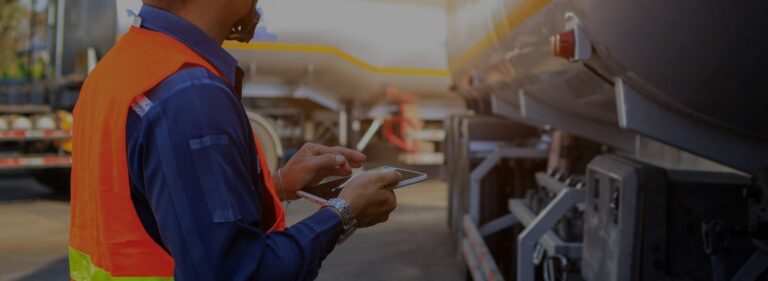Author: Holger Süß

Comparing QR Codes and RFID Cards for Optimizing Plant Logistics
Efficient bulk material logistics rely on seamless processes for truck handling at the plant. To ensure this, industries have long relied on modern tools that speed up the processes of registration, weighing, and loading/unloading, while also reducing the personnel effort required.
For years, RFID cards have been a popular tool for these tasks. However, QR codes are increasingly being recognized as a superior alternative. This article will explore the advantages of QR codes over traditional RFID cards and demonstrate how they can be easily integrated into existing workflows.
Advantages and Disadvantages of RFID Cards
RFID cards have long been the go-to solution for truck handling in plant logistics, particularly in the bulk goods industry. From access control at the gates to weighing, loading, unloading, and exit procedures, drivers rely on RFID cards for various tasks.
Key Advantages of RFID Cards:
- Portability: Easy to carry.
- Versatility: Suitable for multiple uses.
- Global Adoption: Widely recognized and used worldwide.
Despite their widespread use, RFID cards come with several drawbacks. These include costs associated with card creation, management, and replacement, as well as security concerns. Additionally, the cards can be lost or damaged, leading to operational delays. Many drivers also find it challenging to replace lost cards, particularly when they are required to cover the costs themselves.
For these reasons, businesses are increasingly adopting digital alternatives like QR codes, which provide a more efficient and flexible solution. QR codes allow drivers to securely transfer necessary data to their mobile devices, regardless of time or location.

Advantages of QR Codes Over RFID Cards
Data Storage
Unlike RFID cards, which primarily serve as identification tools, QR codes can store additional data beyond basic identification. For instance, QR codes can contain the driver’s name, carrier information, truck license plate, and other application-specific details. They can even identify the cargo or provide details about pickup and drop-off instructions. This added flexibility streamlines processes like material loading and unloading at plants.
When paired with mobile apps, QR codes eliminate the need for drivers to input information manually at check-in terminals, ensuring a faster and error-free process. By digitally transmitting necessary data, QR codes reduce human errors and keep workflows running smoothly.
Time and Cost Savings
QR codes offer significant financial benefits compared to physical cards with RFID chips. They accelerate workflows and eliminate the need for physical card investments, as well as maintenance-intensive card dispensers and readers. QR codes also have an unlimited lifespan, unlike RFID cards that require replacement. Additionally, in case of loss, QR codes can be transmitted digitally — via email or a dedicated mobile app — rather than requiring physical reissuance.
In terms of cost, QR codes are less expensive to create and maintain compared to RFID cards. They also simplify the issuance process by enabling real-time, digital distribution. For example, a QR code for pickup instructions can be sent to the driver’s mobile device before arrival, providing all necessary transaction details in upfront and reducing the risk of delays.
Key Advantages of QR Codes:
- Cost-Effective: No production and maintenance costs.
- Ease of Creation: Simple and quick to generate.
- Digital Transmission: Facilitates instant sharing and updating.
- User-Friendly: Compatible with mobile devices (e.g., Wallet apps, ticket applications).
- Flexible File Formats: Supports multimedia formats like JPEG, PDF, and others.
- Durability: More resistant to damage than RFID cards.
- Mobile Integration: Scannable via smartphones.
- Enhanced Security: Options for encryption and digital signatures.
Utilization of QR Codes in Mobile Apps
The most efficient way to utilize QR codes is through a mobile app. This approach allows truck drivers to store all necessary documents, including information about their route, cargo, or specific details about the plant, along with the QR code itself. All relevant data is centrally consolidated within the app, ensuring it is immediately accessible.
Advantages of Digital QR Codes Upon Arrival at the Plant:
- Contactless self-service check-in.
- Elimination of human errors or incorrect entries.
- Faster check-in processes.
- Immediate access to all relevant information.
- Dynamic updates as needed.
Mobile app-based systems have been thoroughly tested in practice. For example, Axians IAS, a provider of bulk logistics software, has developed a specialized VAS Mobile App for this purpose. In addition to QR code downloads, it integrates digital delivery notes, enabling drivers to access all required information on their mobile devices. This approach supports flexible planning, as updates can be instantly communicated to drivers via the app.
Alternatives to Digital Transmission
If a QR code cannot be transmitted digitally, generating one manually is a straightforward solution. For instance, the code can be created and handed to the driver on a loading note. Additionally, QR codes can be generated automatically when drivers check in at the plant, typically through a self-service terminal.
Workarounds for Drivers Without a QR Code Upon Arrival:
- Use a self-service terminal or consult an employee at the entry gate.
- Manually enter the required data (similar to existing procedures).
- Printout of a loading note with QR-Code on-site.

Technical Implementation of QR Code Solutions
Implementing a QR code solution is straightforward. Instead of issuing physical RFID cards, drivers only need a mobile device equipped with a QR code or app. For facilities utilizing self-service check-in, terminals must also be equipped to read QR codes. To maximize flexibility in the switch-over phase, these terminals can support both QR-Codes and RFID cards while maintaining the option for manual data entry.
The solution requires no training time, especially for mobile app users who are already familiar with digital processes. Onboarding can be seamlessly integrated into regular operations, saving time for plant personnel and drivers. Unlike the cumbersome process of replacing lost RFID cards, lost QR codes can now be quickly reproduced and transmitted to drivers with just a few clicks.
Case Study: Integration of QR Codes at Axians
Users of Axians’ VAS system benefit from the seamless integration of QR codes into their app. This solution simplifies delivery processes by consolidating all required online documentation, ensuring consistency across the board. Available for both Android and iPhone, the app integrates with VAS Yard Management and VAS Cloud Logistics, enabling smooth operations through standardized interfaces.
To meet diverse client needs, Axians provides various VAS modules tailored to specific requirements. Their solutions offer scalability and adaptability, from consultation to installation and commissioning. Furthermore, customers gain access to Axians’ expert team, ensuring seamless system implementation and ongoing support.
Thanks to QR code integration, Axians’ solution for loading and shipping in bulk logistics has significantly enhanced its flexibility and expanded its range of applications. QR codes have now become integral to logistics processes, ensuring consistency and reliability throughout operations.
Conclusion
QR codes offer several advantages over RFID cards. Their scalability makes them particularly appealing for larger operations, where the cost and maintenance of RFID cards can become burdensome. Another notable benefit is the increased sustainability that QR codes provide by reducing plastic consumption and lowering CO2 emissions.
Moreover, the future of logistics systems seems poised to transition to digital solutions. As technology continues to evolve, physical tools like RFID cards are likely to decline in favor of more flexible alternatives such as QR codes. This transition is driven by their ability to seamlessly incorporate additional features and provide instant, reliable data transmission without added complexity. Technical modifications are straightforward, and the corresponding software adjustments are easy to implement and scale effectively. Together, these factors contribute to making bulk logistics processes simpler, faster, and more efficient.

Holger Süß
Team lead presales & project management
We work with you to design a customized solution.
Let us turn your challenges into successes – contact us today!
You are currently viewing a placeholder content from HubSpot. To access the actual content, click the button below. Please note that doing so will share data with third-party providers.
More Information

